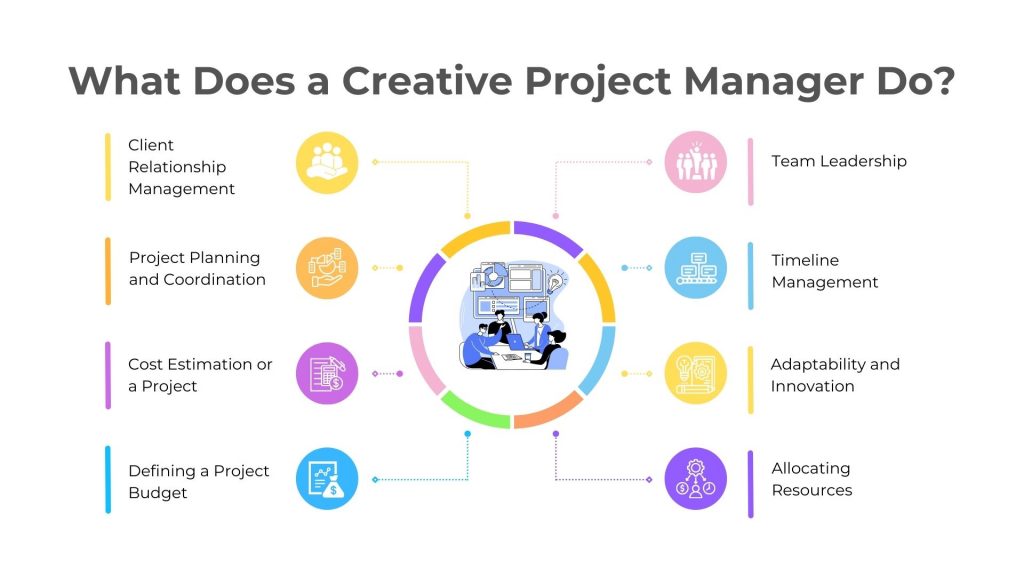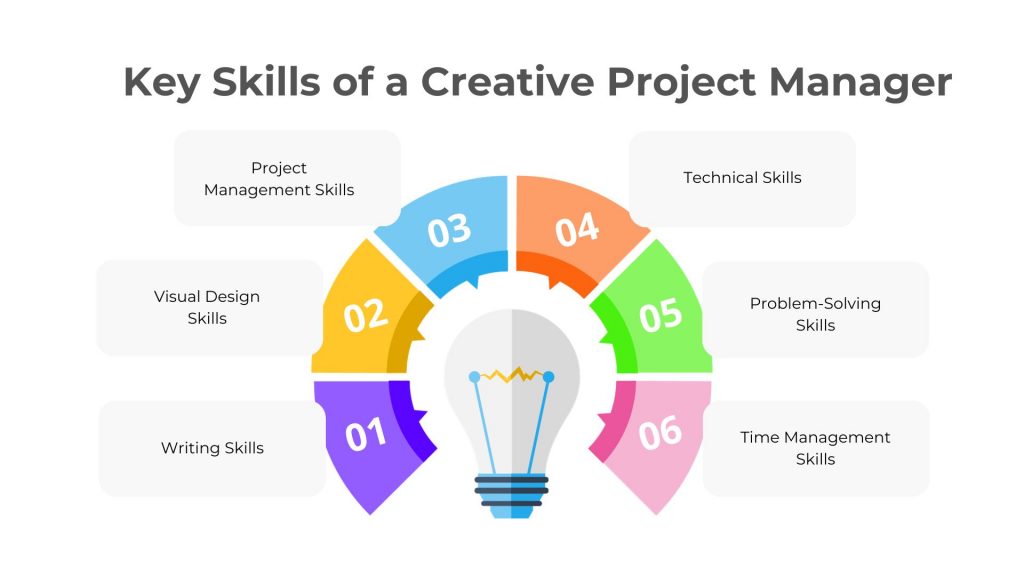
In today’s dynamic realm of creative endeavors, where innovation meets execution, the role of a creative project manager emerges as a linchpin for success. Creative Project Managers are the architects of seamless collaboration, ensuring artistic visions flourish, meet deadlines, and stay within scope.
They are marketing experts supervising creative initiatives within an organization or for client companies. These initiatives encompass a diverse range, including videos, infographics, content writing, and advertising copy.
A career as a creative project manager could be exceptionally fulfilling if you’re seeking a profession that melds organizational skills with creativity. In this article, we’ll explore the unique skill set, diverse roles, and multifaceted responsibilities that define the creative project manager’s contribution to successfully executing creative endeavors.
Table of Contents:
- What is a Creative Project Manager?
- Key Roles & Responsibilities of a Creative Project Manager
- What Skills are Essential for a Creative Project Manager?
- How to Become a Creative Project Manager?
- Common Challenges that a Creative Project Manager Faces
- Creative Project Manager Vs. Technical Project Manager
- Conclusion
What is a Creative Project Manager?
A Creative Project Manager is a professional within the field of marketing who assumes a central role in overseeing and coordinating various creative projects for an organization or a client. These projects typically involve the development and execution of creative content, such as videos, infographics, written content, and advertising materials.
The Creative Project Manager serves as a bridge between the creative team and the organizational objectives, ensuring that projects are innovative and engaging and delivered within established timelines and budgets.
This role demands a unique combination of organizational prowess and creative insight, making it a rewarding career path for individuals who thrive at the intersection of structured project management and imaginative endeavors.
Key Roles & Responsibilities of a Creative Project Manager
The roles and responsibilities of a creative project manager encompass a diverse array of tasks to ensure the successful planning, execution, and completion of creative projects within an organization. Here’s a breakdown of the key aspects:
1. Client Relationship Management
Creative Project Managers bridge the creative team and clients, ensuring effective communication and collaboration. They maintain strong client relationships by regularly updating them on project progress, addressing feedback, and aligning the project with client expectations.
2. Project Planning and Coordination
Creative Project Managers are responsible for the initial planning phase of a project. This involves defining project scope, objectives, timelines, and deliverables. They collaborate with stakeholders to understand requirements and ensure creative projects align with organizational goals.
3. Cost Estimation for a Project
Creative Project Managers work with the creative team to assess resource needs, providing accurate estimates for project costs. This involves a thorough understanding of the creative process, industry standards, and potential variables that may impact costs throughout the project.
4. Defining a Project Budget
Building on cost estimates, Creative Project Managers establish a comprehensive project budget. This financial guide ensures proper resource allocation, balancing the project’s financial viability with creative standards from pre-production to delivery.
5. Team Leadership
Effective leadership is crucial as creative project managers lead and inspire creative teams. They assign tasks, set priorities, and foster a collaborative environment to maximize the team’s creative output. Clear communication and motivation are key in this aspect of the role.
6. Timeline Management
Meeting project deadlines is a fundamental aspect of the role. Creative Project Managers create realistic timelines, monitor progress, and implement adjustments to keep projects on schedule.
7. Adaptability and Innovation
Creative Project Managers excel in adapting to dynamic project demands and fostering an innovative atmosphere. They stay updated on industry trends, encourage the creative team to think outside the box, and swiftly adjust strategies to overcome challenges. By instilling a culture of adaptability, they ensure the team can navigate evolving project requirements, delivering creative solutions that resonate in the competitive landscape.
8. Allocating Resources
Efficient resource allocation is a key responsibility. Creative Project Managers assign tasks based on team members’ skills, distribute materials, and coordinate with external partners. Optimizing resource allocation enhances productivity and contributes to the successful execution of the project.
Enroll in globally recognized Project Certification courses with Invensis Learning and land in your dream job!
What Skills are Essential for a Creative Project Manager?
A creative project manager’s skills include overseeing a team that completes creative marketing initiatives such as new website designs, advertising material, and video content. The skills of a creative project manager may vary depending on the size of their team and the type of projects they develop. Here’s an overview of the key skills required for a creative project manager:
1. Project Management Skills
This skill set involves planning, executing, and overseeing projects from initiation to completion. Project management skills include defining project goals, setting timelines, allocating resources effectively, and ensuring that the project stays on track and within budget.
2. Visual Design Skills
Visual design skills pertain to creating aesthetically pleasing and effective visual elements. This can include a keen eye for layout, color, typography, and overall design principles, enabling the creative project manager to contribute to the visual aspects of a project.
3. Writing Skills
Strong writing skills are essential for clear and effective communication. Creative Project Managers with proficient writing skills can articulate project goals, create compelling project proposals, and facilitate smooth communication with clients, team members, and other stakeholders.
4. Technical Skills
Technical skills encompass understanding and working with relevant tools and technologies in the creative domain. This could include proficiency in software used for graphic design, video editing, project management, or any other tools essential for the successful execution of creative projects.
5. Problem-Solving Skills
Problem-solving skills involve the capacity to identify challenges that may arise during a project and devise effective solutions. Creative Project Managers with strong problem-solving skills can navigate obstacles, adapt strategies, and ensure the project progresses smoothly.
6. Time Management Skills
Time management skills are crucial for prioritizing tasks, setting realistic deadlines, and ensuring project milestones are achieved on time. Effective time management allows creative project managers to maintain project momentum and meet client expectations within specified timeframes.
How to Become a Creative Project Manager?
Becoming a creative project manager involves a strategic combination of education, experience, and honing a diverse skill set. Here’s a concise guide on how to embark on this career path:
1. Educational Background
Obtain a relevant educational background, typically in fields such as marketing, communications, business, or project management. A bachelor’s degree is often a common requirement, although some employers may prioritize relevant experience and skills.
2. Build Project Management Skills
Develop strong project management skills by pursuing project management certification courses. Familiarize yourself with project management tools and software commonly used in the industry.
3. Gain Experience
Acquire practical experience in project management and the creative industry. Seek internships, freelance opportunities, or entry-level positions involving project coordination or creative collaboration to build a solid foundation.
4. Networking
Network within the creative and project management communities. Attend industry events, join professional organizations, and connect with professionals in both fields. Networking can open doors to potential opportunities and provide valuable insights into the industry.
5. Develop Communication Skills
Strengthen your communication skills, both written and verbal. Clear communication is crucial in liaising between the creative team, clients, and other stakeholders.
6. Build a Portfolio
Create a portfolio showcasing your project management experience and any relevant creative projects you’ve been involved in. Highlight your strengths in managing projects from conception to completion.
Common Challenges that a Creative Project Manager Faces
Even though creative project managers play a crucial role in project management, they encounter unique challenges. Below, we have mentioned the challenges and provided practical strategies to empower creative project managers in steering projects toward success amidst the complexities of the creative landscape.
Challenge 1: Scope Creep
Challenge: The project scope expands beyond its original boundaries, leading to increased work and potential delays.
How to Avoid?
- Clearly define and document the project scope from the outset
- Establish a change management process to assess and approve any alterations to the scope, ensuring that changes align with project goals and timelines
Challenge 2: Resource Constraints
Challenge: Limited resources, whether in terms of personnel, time, or budget, can pose significant challenges to project success.
How to Avoid?
- Conduct thorough resource planning at the project’s initiation
- Regularly reassess resource needs throughout the project lifecycle and communicate proactively with stakeholders about potential constraints
- Prioritize tasks based on available resources and consider outsourcing when necessary
Challenge 3: Communication Breakdowns
Challenge: Ineffective communication between team members, clients, and stakeholders can lead to misunderstandings, errors, and delays.
How to Avoid?
- Establish a robust communication plan that outlines channels, frequency, and key contacts
- Foster an open and collaborative environment where team members feel comfortable expressing concerns
- Utilize project management tools to facilitate transparent communication and keep all stakeholders informed
Challenge 4: Timeline Pressures
Challenge: Tight deadlines and time constraints can compromise creative output quality and elevate team stress levels.
How to Avoid?
- Develop realistic timelines during the project planning phase, considering the scope and complexity of the project
- Regularly monitor progress and be prepared to reassess and adjust timelines as needed
- Communicate any changes to the team promptly to manage expectations
Challenge 5: Client Expectations
Challenge: Managing and aligning client expectations with project realities can be challenging, leading to potential dissatisfaction.
How to Avoid?
- Conduct thorough initial discussions with clients to understand their expectations and requirements
- Provide regular updates on project progress and proactively communicate any challenges or changes
- Ensure that clients are involved in key decision-making processes to maintain alignment
Challenge 6: Balancing Creativity and Constraints
Challenge: Finding a balance between creative freedom and project constraints, such as budget and deadlines, can be delicate.
How to Avoid?
- Foster a collaborative environment that encourages creative input while setting clear boundaries and expectations
- Establish a creative brief that outlines project goals, constraints, and key deliverables
- Regularly review and align the creative vision with project objectives
Creative Project Manager Vs. Technical Project Manager
| Aspect | Creative Project Manager | Technical Project Manager |
| Primary Focus | Creative and artistic projects | Technical and technology-driven projects |
| Core Skill Set | Strong creative and design understanding, excellent communication, project management | Technical expertise, problem-solving, analytical skills, project management |
| Industry Emphasis | Advertising, marketing, design, media | Information technology, software development, engineering |
| Project Types | Graphic design, video production, content creation | Software development, IT infrastructure, engineering projects |
| Decision-Making | Balancing creative vision with project constraints | Analyzing technical requirements and making decisions based on feasibility |
| Client Interaction | Collaborating with clients on creative concepts, managing expectations | Communicating technical details to clients, managing expectations regarding project outcomes |
| Metrics of Success | Aesthetic appeal, creativity, client satisfaction | Functionality, efficiency, adherence to technical specifications |
| Documentation | Emphasis on visual representations, creative briefs | Detailed technical documentation, specifications, and code documentation |
| Team Collaboration | Collaborating with creative teams, designers, and content creators | Coordinating with technical teams, developers, engineers, and IT professionals |
| Risk Management | Dealing with subjective risks related to creative vision and client satisfaction | Managing technical risks, ensuring software/hardware compatibility, and addressing coding challenges |
| Adaptability | Adapting to evolving creative trends and client preferences | Adapting to emerging technologies, changes in coding languages, and evolving industry standards |
| Final Deliverables | Creative assets such as designs, videos, marketing materials | Technical solutions, software applications, IT infrastructure implementations |
| Communication Style | Emphasizing visual communication, storytelling | Precision in technical communication, using technical jargon when necessary |
| Timeline Considerations | Balancing creative process timelines with project deadlines | Managing complex technical timelines, accounting for potential delays in coding or testing |
Also read out the blog to understand the Role of a Marketing Project Manager!
Conclusion
In conclusion, a creative project manager stands at the intersection of artistic vision and strategic project management, weaving together innovation and organization. The skills, roles, and responsibilities explored in this blog underscore the dynamic nature of this role, where effective communication, adaptability, and a nuanced understanding of both creative processes and project parameters are paramount.
Aspiring creative project managers and seasoned professionals alike can glean valuable insights, recognizing that success in this position transcends meeting deadlines—it entails fostering a collaborative environment that nurtures creativity and delivering projects that exceed expectations.
The journey of a creative project manager is a symphony of creativity and strategy, shaping the landscape of the creative industry with each project.
















